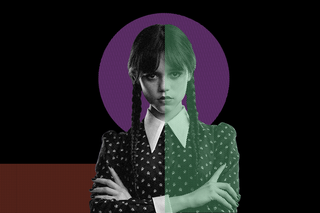
Netflix’s Wednesday Is a Lesson in Paying Homage While Adapting to the Times
Wednesday’s appeal is proof that the beauty of familiarity and nostalgia can go hand-in-hand with an original story rooted in the present.

This article contains spoilers for Season 1 of Wednesday.
Wednesday — Netflix’s latest horror comedy centered around its eponymous protagonist, Wednesday Addams, from the infamous Addams family — premiered last week, trending on the platform’s Top 10 list by the weekend in India. Played by a brilliantly cast Jenna Ortega, the show’s fictional protagonist tweeted, “All of the attention this weekend has been pure torture. Thank you.” As its viewers, what we should, perhaps, be thankful for is Wednesday proving that the appeal of familiarity and nostalgia can go hand-in-hand with a story that’s not just original, but also aware of the cultural environment of the present — together, these ingredients brewed up a concoction that’s as compelling as it is heady.
In an era of remakes and plagiarized content being paraded as “inspiration” and “tribute,” Wednesday serves as a welcome reminder that it is possible to pay homage to existing pieces of work without ripping them off. Instead, it has its antagonist’s pet demon literally rip people off in the macabre style one has grown to associate with The Addams Family they watched — and, in the case of many like myself, loved — as children. Brought to life by Tim Burton’s signature morbid imagination, Netflix’s Wednesday might serve as the introduction to Spookverse’s “first family” for yet another generation of “normie spawns,” as Wednesday would probably say.
Given that the show rides on the nostalgia of American cartoonist Charles Addams’ creation, of course, it stayed true to the essence of The Addams Family. But that wasn’t the show’s lone draw rooted in familiarity — from Mean Girls-ish high school cliques, to a Clueless and Gossip Girl-inspired role of the “Queen Bee” (although Wednesday features actual bees, too, in a rather pivotal swarm), to the Smallville-ish town of Jericho where the Hogwarts-like school, Nevermore Academy, is situated. Wednesday‘s whodunit tone brings to mind Agatha Christie’s works, too.
Moreover, with vampires and werewolves in attendance at Nevermore, the show was mildly reminiscent of the Twilight universe, too. As much as the franchise is dissed in pop culture today, the popularity of the vampire-themed romance — that inspired five hugely successful movies, made Kristen Stewart and Robert Pattinson household names, and birthed Fifty Shades of Grey, yet another flourishing franchise — is almost unparalleled in the young adult genre.
Related on The Swaddle:
‘The Marvelous Mrs. Maisel’ Shows How Society Dismisses Women As ‘Failures’ for Each Career Setback
Given the innumerable threads of nostalgia — including casting Christina Ricci, the former Wednesday Addams, in the role of the antagonist — that Wednesday‘s makers attempted to pull at, it’s a miracle the show still managed to have an original storyline. The murder, mystery, suspense, jumpscare, drama, and even wholesomeness — much to Wednesday’s distaste, surely — were all excellent in their own right. But what took the (moldy, cyanide-laced) cake was the show being strongly rooted in the present — not just by embedding the technology-driven lifestyle of today into its narrative, but also by being aware of the social justice issues plaguing modern society. Wednesday’s battle against the masculine, white supremacy speaks to the show’s refusal to shy away from polarizing accounts.
Interestingly, the show didn’t go on to make grand displays of woke-ness — in fact, its “aware” moments were often subtle, validating the struggles that many of its viewers have probably undergone, without pretending to be their savior. In fact, in the grand scheme of the narrative, many might even forget these threads existed, but for people like me — whose woes the story endeavored to acknowledge — they’ll, perhaps, remain everlasting moments of recall.
Here’s an example: the show doesn’t solve the crisis of women not being believed, which the #MeToo era highlighted; instead, it recognizes the persistent dilemma and delves into the cost of not believing survivors of sexual assault.
In a similar — albeit more inconspicuous vein — the show also brings up the angst of queer people, who are pressured into undergoing conversion therapy by their families. Enid Sinclair (played by Emma Myers) isn’t expected to undergo the ordeal to strip her of her queerness, though; the reason she doesn’t fit in with her family is that, unlike the rest of them, she hasn’t “wolfed out” yet. Through this narrative, the show manages to stay true to its subject while also bringing forth the anguish of not being accepted by one’s family simply because one is different. Enid’s rainbow-colored room and highlights, too, appear to be a nod to the interpretation rooted in queer suffering.
Related on The Swaddle:
‘Eternally Confused…’ Shows How Self‑Hatred Can Damage Everything From Relationships to Careers
Mental health — among the foremost topics of debate and discussion, both online and in real life — also occupies critical space in Wednesday‘s narrative. Instead of the usual lectures on the omnipotence of therapy, though, Wednesday sheds light on how the professional mental health space is notorious for invalidating the lived experiences of non-neurotypical people in a bid to rationalize them. That’s a bitter truth neurodivergent people are consistently agitating against. At the same time, however, the show doesn’t villainize its only mental health professional — Dr. Valerie Kinbott (played by Riki Lindhome) — either. In fact, it proves that Wednesday was wrong to do so. Wednesday‘s makers also attempted to put in a good word about the advantages of family therapy.
Overall, Wednesday acknowledges the reality of the mental health space, at the moment, while recognizing that therapy is, perhaps, our best bet in a world as messed up as the present.
What also merits a mention, here, is the apparent neurodivergence of Wednesday Addams. Is she indeed autistic? We don’t know yet. But what makes her autistic-coding more palatable, perhaps — especially compared to The Big Bang Theory‘s Sheldon Cooper, which was written and played by merely “utiliz[ing] some of those ‘Aspergian’ traits” as though autism is a plot device; and BBC’s Sherlock where autism and sociopathy are used almost interchangeably to describe the central character’s eccentricities — is the fact that it’s the creation of Tim Burton, who, reportedly, identifies as autistic himself.
So, for me, as an autistic person, Wednesday also spoke to the power of representation. And, the fact that the “non-normie outcasts” banded together in the end to fight their “normie enemy” was, for me, yet another instance of disability communities offering support, belongingness, and strength to disabled individuals who are, often, denied precisely that in a “normal”-obsessed culture.
Devrupa Rakshit is an Associate Editor at The Swaddle. She is a lawyer by education, a poet by accident, a painter by shaukh, and autistic by birth. You can find her on Instagram @devruparakshit.
Related


Woe Is Me! “How Do I Make Time For Myself With a Hectic Work Schedule?”
